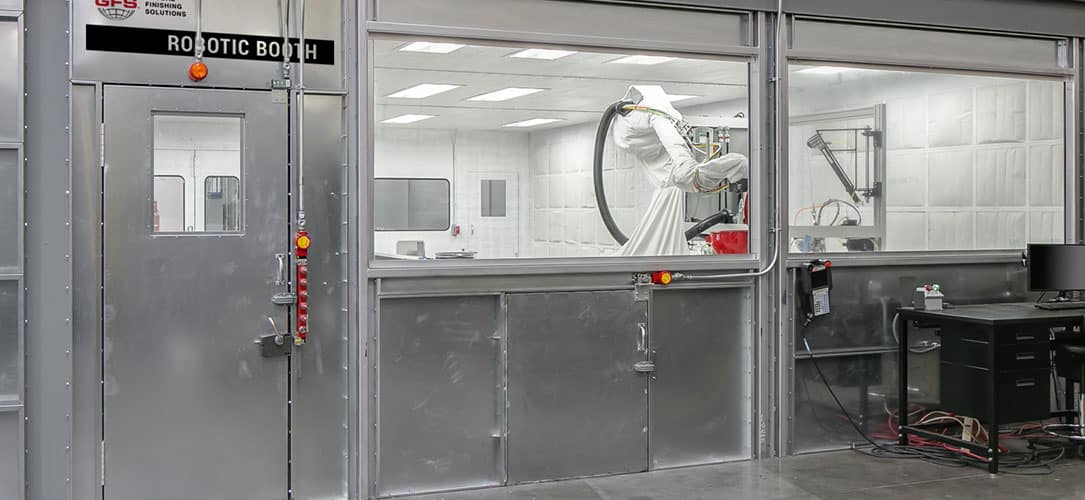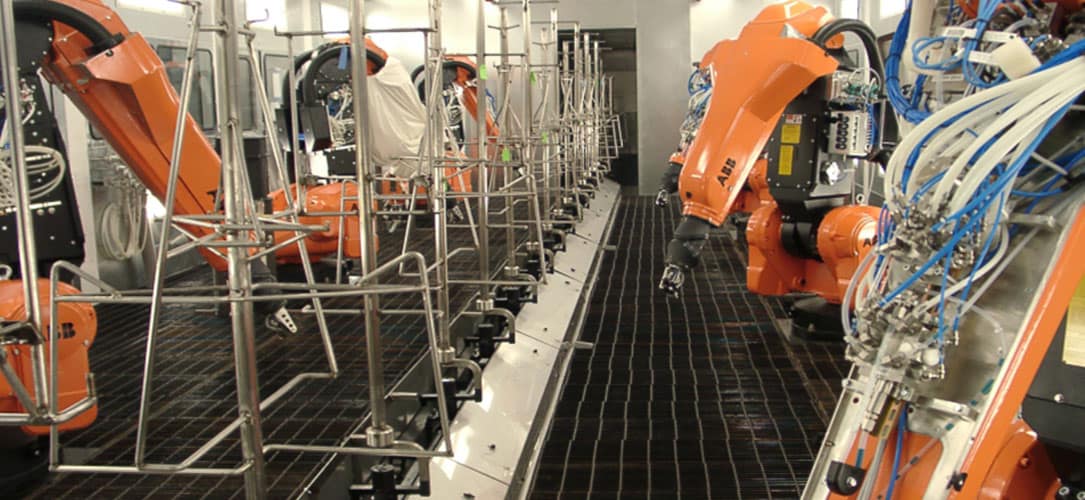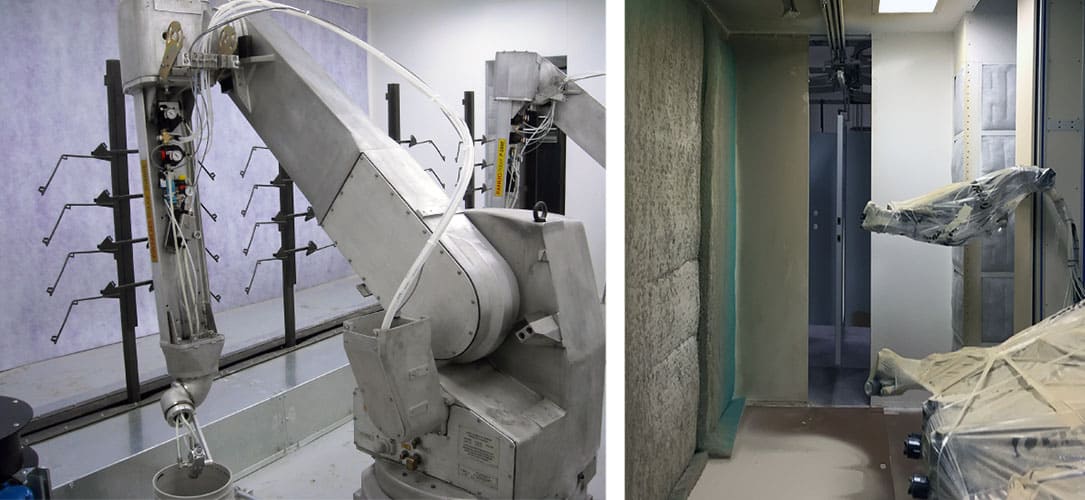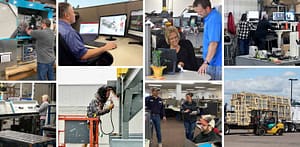
As industrial manufacturers and aircraft finishers attempt to remain competitive and meet production challenges, they face a high demand for faster lead times, despite a dwindling workforce. In some cases, they are having to do more with less.
Integrating painting robots into your finishing operation can free up floor space, increase productivity and improve finish quality — while workers can be transitioned into more beneficial roles. In the long run, a painting robot can be cheaper, more accurate and more reliable than a manual painter, with the ability to essentially work around the clock.
Here are five things you need to know before adding a painting robot to your industrial or aerospace paint booth:
There are three different ways to mount painting robots in a spray booth — on the floor, on a wall or on the ceiling.
Floor-mounted painting robots consume the most space, yet integrating them into a spray booth is less complicated than integrating wall-mounted or ceiling-mounted robots. To accommodate a wall-mounted painting robot, a mounting position must be designed in the wall of a paint booth, then a column can be installed on the outside with a vertical base plate. Similarly, a hole is designed in the ceiling of a spray booth for a ceiling-mounted painting robot, which is bolted to overhead beams.
For businesses finishing large products, a wall-mounted or ceiling-mounted painting robot may be a better option than a floor-mounted robot because of the space required. If there are no space restrictions, floor-mounted painting robots are easiest to integrate into a finishing operation, as holes do not need to be cut in the wall or ceiling of the paint booth.
“The paint booth’s walls or ceiling must be designed to accommodate painting robots,” said Mark Freels, a Territory Manager for Global Finishing Solutions (GFS). “The booth becomes a much different structure when you bolt a painting robot to it. There are a lot of dynamic forces at play.”

The function of painting robots in spray booths varies with the application. For low-production, automated batch process applications, a worker stands at the front of the spray booth, typically loading and unloading parts off a turntable while the painting robot applies material to parts inside the booth. Another configuration has parts shuttled across the spray booth, with the worker loading parts, then unloading them after they are sprayed by the painting robot.
In high-production, continuous process applications, large products, such as car bodies, move through paint booths, with painting robots spraying from both sides of the vehicle. Or small parts hang from a conveyor, as an overhead monorail carries parts in front of the painting robot, which sprays toward the part and the filtered exhaust chamber behind it.
By recirculating up to 90 percent of the exhausted air, recirculating paint booths use significantly less energy than traditional industrial paint booths. Not only is energy usage greatly reduced, but capital expenses are also decreased, as the air handling and abatement equipment are reduced in size.
Since the exhausted air is recirculated back into the paint booth during spray mode, volatile organic compounds (VOCs) can be reintroduced into the booth, which are hazardous for the painter. As a result, the painter often is required to use a high level of personal protective equipment (PPE), whereas painting robots are immune to the health hazards that may be detrimental to human painters.
“You drop a painting robot in a recirculating spray booth, and it doesn’t care about VOCs in the booth. You just have to stay below the maximum operating temperature of the robot, which is approximately 115 degrees Fahrenheit,” Freels said. “So now you are heating significantly less air with a recirculating paint booth — an approximately 40 percent decrease in conditioned process air.”
Robots enable users to improve quality and throughput, while simultaneously reducing capital and operational costs. Robot technology allows movement of applicators (tip speed) well above any manufacturer’s maximum tip speed. The high speed/payload arms are used to increase throughput by allowing for heavier applicator/multiple applicator processes that can apply more paint than a manual painter in the same operating space. High arm speeds also equate to faster reposition time to the next part, equating to more spray time.
The advantage of a painting robot is that it paints exactly the same over and over again, whereas humans are prone to painting thicker or thinner the longer they spray in a single shift. The consistency of painting robots results in cascading cost savings — a decrease in rework and tighter film build tolerance, leading to less paint and filter usage, which equates to smaller exhaust (conditioned air).
This is especially important when painting with performance coatings, such as low observable coatings used on military aircraft and components. Low observable coatings require multiple applications in precise thicknesses and distribution. Painting robots can be programmed to apply a very specific amount of low observable coating to the product, increasing efficiency and reducing waste in the paint process.

Painting robots are ideal for finishing objects that are difficult to paint, as they can more easily access hard-to-reach spots. They are especially beneficial when painting highly contoured surfaces, such as on aircraft components, which can be extremely challenging to paint manually.
For the precise application of paint on all areas of the component with a painting robot, the component must be stationary and placed in the same position every time.
“Conveyors with single-point hanger hooks to present parts to the robot are not recommended for robotic paint application,” Freels said. “Customers must have repeatable part presentation, with parts typically conveyed on a metal frame or two-point hook connection. A repeatable position conveyance is recommended as part of a painting robot system.”
Integrating a painting robot should be a consideration early in the paint booth design process, since booths built to house robots are custom. It is best to work with a trusted paint booth manufacturer that is experienced at integrating robotics, such as GFS.
Like computers and TVs, painting robots continue to become more sophisticated, while also becoming more economical. The get-in-the-door price for a painting robot is about $150,000. It is often an investment worth making for industrial manufacturers and aircraft finishers looking to streamline their operations, establish more consistency in their finish quality and increase their energy savings.
One of the best ways to highlight your business is through a story that you can share across your online platforms. It humanizes your business and shows that your business can make a meaningful impact. Your testimonial would be used as a project profile on the GFS Booth Blog and can be shared on your website and/or social media channels.
Complete this form and we’ll be in touch to showcase your company.

Shop a variety of GFS aftermarket products, including booth protection products and mobile accelerated curing units. And enjoy the convenience of fast and free ground shipping throughout the contiguous United States.

Located at GFS’ headquarters in Osseo, Wisconsin, the Center for Excellence is an innovative facility featuring an automotive refinish training center, as well as a separate space dedicated to technical product training.

GFS is continuously searching for talented, ambitious individuals to join our team. We aim to provide our employees with every opportunity to make an impact on the company and find their niche along the way — weather in a production, field services or an office position.